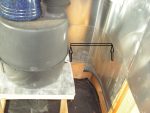On October 22, 1575, the Mexican State of Aguascalientes (one of 32 Federal Entities of Mexico) was founded. The full name of the state is Estado Libre y Soberano de Aguascalientes. Literally, Aguascalientes means: “Hot waters”. JWR Adds: My maternal grandfather Dewitt Creveling was born December 3, 1903, in Aguascalientes, Mexico. He was the son of an ex-pat American mining engineer. He liked to say: “I was born in hot water, and I’ve been in hot water all my life.”
On October 22, 1934, infamous criminal Charles (“Pretty Boy”) Floyd was fatally shot in a field near East Liverpool, Ohio, by FBI agents.
On October 22, 1797, André-Jacques Garnerin, an inspector in the French army who encouraged the use of balloons for military purposes, made a balloon ascent in order to give his first exhibition of parachuting, when he jumped from a height of about 3,200 feet (1,000 meters).
This is the birthday of painter and book illustrator N.C. Wyeth (1882–1945). It is also the birthday of actor Jeff Goldblum (born 1952), who had unforgettable roles in Buckaroo Banzai and in the Jurassic Park and Independence Day films.
—
SurvivalBlog Writing Contest
Today we present another entry for Round 115 of the SurvivalBlog non-fiction writing contest. The prizes for this round include:
First Prize:
- The photovoltaic power specialists at Quantum Harvest LLC are providing a store-wide 10% off coupon. Depending on the model chosen, this could be worth more than $2000.
- A Gunsite Academy Three Day Course Certificate. This can be used for any of their one, two, or three-day course (a $1,095 value),
- A Peak Refuel “Wasatch Pack” variety of 60 servings of premium freeze-dried breakfasts and dinners in individual meal pouches — a whopping 21,970 calories, all made and packaged in the USA — courtesy of Ready Made Resources (a $350 value),
- American Gunsmithing Institute (AGI) is providing a $300 certificate good towards any of their DVD training courses. Their course catalog now includes their latest Survival Gunsmithing course.
- HSM Ammunition in Montana is providing a $250 gift certificate. The certificate can be used for any of their products.
Second Prize:
- A SIRT STIC AR-15/M4 Laser Training Package, courtesy of Next Level Training, that has a combined retail value of $679
- Two 1,000-foot spools of full mil-spec U.S.-made 750 paracord (in-stock colors only) from www.TOUGHGRID.com (a $240 value).
- A Laptop EMP Shield and a Smartphone Faraday Bag (a combined value of $200), courtesy of MobileSecSolutions.com.
- Two sets of The Civil Defense Manual, (in two volumes) — a $193 value — kindly donated by the author, Jack Lawson.
- Two Super Survival Pack seed collections, a $150 value, courtesy of Seed for Security, LLC.
- A transferable $150 FRN purchase credit from Elk Creek Company, toward the purchase of any pre-1899 antique gun. There is no paperwork required for delivery of pre-1899 guns into most states, making them the last bastion of gun purchasing privacy!
Third Prize:
- A Berkey Light water filter, courtesy of USA Berkey Filters (a $305 value),
- Three sets each of made-in-USA regular and wide-mouth reusable canning lids. (This is a total of 300 lids and 600 gaskets.) This prize is courtesy of Harvest Guard (a $270 value)
- A $200 credit from Military Surplus LLC that can be applied to purchase and/or shipping costs for any of their in-stock merchandise, including full mil-spec ammo cans, Rothco clothing and field gear, backpacks, optics, compact solar panels, first aid kits, and more.
- A transferable $150 FRN purchase credit from Elk Creek Company, toward the purchase of any pre-1899 antique gun.
—
More than $925,000 worth of prizes have been awarded since we started running this contest. In 2023, we polled blog readers, asking for suggested article topics. Please refer to that poll if you haven’t yet chosen an article topic. Round 115 ends on November 30th, so get busy writing and e-mail us your entry. Remember that there is a 1,500-word minimum, and that articles on practical “how-to” skills for survival have an advantage in the judging.

















